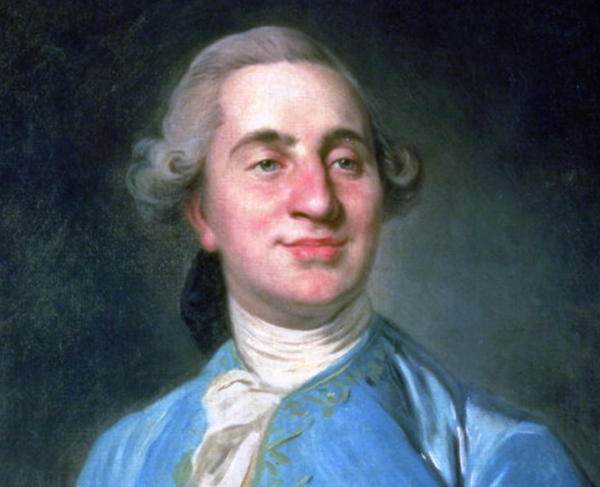Louis XVI: C’est une grande révolte!
La Rochefoucault-Liancourt: Non, Sire, c’est une grande révolution.
Upon learning of the fall of the Bastille in the summer of 1789, Louis XVI—the hapless (and soon to be headless) French king against whom popular opinion in the country had long since turned—responded with one of the great understatements of which history has preserved a record. Unable fully to appreciate the gravity of the Bastille’s collapse, and to anticipate the violent intentions of the revolutionaries by whom it was stormed, he fell back into his chair, let out a gasp and, in a tone of anxious disbelief, exclaimed, “Why!—this is a revolt!”
In unison, all the well-dressed, freshly-perfumed courtiers by whom he was surrounded that fateful July day nodded their heads in quiet agreement, save one brave and foresightful man, the magnificently-named François Alexandre Frédéric, Duc de La Rochefoucault-Liancourt, who took it upon himself to step up before the dumbstruck group of nobles and, without any hesitation, to speak his mind.
“No, Sire”, responded the Duc de La Rochefoucault-Liancourt, who’d just arrived at the Palace of Versailles (to which the king, only a few hours earlier, had retired after an uneventful day spent hunting. It was so uneventful, in fact, that he scribbled the following, deliciously ironic entry in his diary: “July 14: Nothing”. Nothing, indeed!) from Paris, the pearl of Europe and the center of unrest at whose quivering heart, the impregnable Bastille once stood. The Duc de La Rochefoucault-Liancourt, a distinguished nobleman descended from one of France’s best families, took it upon himself to correct the king.
It is not a revolt, he countered: “it is a revolution”.
And so it was.
At about one o’clock that afternoon, eighteen crafty, agile rebels succeeded in climbing the walls of a structure adjoining the Bastille, into whose unguarded forecourt they quickly poured out. In haste, they made their way to the two main drawbridges by whose lowering, easier access to the medieval fortress could be had. The Bastille, long symbolic of despotism in France and the embarrassing reign of second-rate Bourbon talent, boasted walls thirty feet thick and one hundred feet high, atop which a slew of cannons and guns were menacingly set. Encircling the entire structure was an impressively wide moat, a daunting body of water across which no-one dared swim.
No sooner had the two drawbridges been lowered than a frenzied crowd of rebels began to stream into the fortress. A few minutes later, two more drawbridges were located and lowered, over which another excited wave of rebels giddily swarmed. Word of the uprising began to spread throughout the more radical enclaves of Paris, whose residents were champing at the bit to make known their displeasure with the state.
Among its many failures, through which the good citizens of France were made, for far too long, to suffer, they were reeling from the crown’s financial mismanagement, its invitation of foreign troops, its extravagant Austrian Queen, a scarcity of bread, a tax on salt, a crisis of identity, and a bumbling King incapable of redressing these expensive and multiplying failures. And so, upon learning of the Bastille’s invasion, they momentarily forgot about their hunger, cast aside their fear, and decided to participate in some real, meaningful action.
They would join in the historic siege, by which the fire of Revolution was, now until the bitter end, officially lit.
Bernard-René Jourdan de Launay, the highborn Frenchman to whom oversight of the Bastille was entrusted, commanded the rebels to stop their riotous misbehavior at once, and to evacuate the state-owned grounds upon which they were now unlawfully intruding. Buoyed by the success of their initial breach, and intoxicated by the idea of a grander conquest to come, the rebels dismissed his order, and, with renewed vigor and purpose, pressed on further.
De Launay, now at risk of losing control of the situation, ordered his troops to fire upon the mob. The mob, in response, decided to fire back. What’s surprising is how long it took for everyone’s muskets to be raised. The whole scene was a tinderbox, merely awaiting a flame.
The bloodshed came disproportionately from the rebels, of whose number ninety-eight died (to only one Bastille guardsman). The trouble was, a kill ratio of 100:1 was, for a thinly staffed and inadequately provisioned Medieval garrison, unsustainable. Sooner or later, the guards would be subdued by hunger or force—neither an especially appealing option. De Launay realized that, if this conflict were to extend much longer, his soldiers would all be spent, while the rebels, like the Hydra’s head, would continue to multiply whenever cut down.
After about four hours of relentless, close-quarters fighting, De Launay threw up his arms, threw down his sword, and hoist the white flag. Vastly outnumbered, low on resources, and with little hope of being relieved, he was forced, at last, to surrender. He hoped to do so while preserving a shred of his cohort’s dignity—a condition to which the mob unsurprisingly refused to consent. He turned over to its leaders the fortress’ key (of which, in the form of a gift from the Marquis de Lafayette, George Washington became the ultimate recipient. The hefty, one-pound three-ounce wrought-iron key is still on display at the great General’s Mt. Vernon estate, of which, in the nearby gift shop, you can purchase yourself a replica!) before being seized by the rebels and dragged outside.
One cringes, at this point, to recount the way in which De Launay’s story ends.
The mob, now victorious, had a decision to make: would it, in civilized fashion, and in keeping with the humane standards of good Christian order, try De Launay in a court of law on the charge of murder? Would it be patient enough to endure the slow workings of that crusty old ancien institution, of which, as of late, it had become so distrustful? Or, fearful of judges and juries tainted with royalist sympathies and conservative scruples, who might look too leniently upon the fate of one of their own members, would it move swiftly to take justice into its own blood-soaked hands, and execute De Launay right there on the spot?
To De Launay’s misfortune, the rebels opted for the latter.
Unprotected by his soldiers (from whom every last piece of weaponry was methodically stripped), De Launay was roughed up, spun about, and violently thrown to the ground. No-one offered to restore him to his feet, and he now lay, like an injured animal, in the dust at the crowd’s mercy. Sadly, as you may have guessed, mercy was, among the gathered revolutionaries, in extremely short and dwindling supply. The mob decided this was as good an opportunity as any to take out their frustrations and beat the detested man, who was, after all, emblematic of everything that was wrong with France.
And, so, beat him they did.
It’s difficult to say whether or not it was their intention to do so until he died, but that was the gruesome, predictable outcome. A shower of fists, a deluge of kicks fell upon the Bastille’s fallen governor, whose battered lungs began to fill up with blood, and whose fading eyes began to roll back in his head. De Launay, unable to resist his attackers, was beat to a pulp, but the indignity of his undoing wouldn’t end with his final breath. The moment he expired, the rebels took up a sword and cut off his head, with which they proceeded to tip an uncapped pike. They then gallivanted through the streets of Paris with De Launay’s severed head on a gore-drenched pole, at the sight of which even some of the strongest-stomached radicals couldn’t but wince.
The Duc de La Rochefoucault-Liancourt, having borne witness to this savagery, was absolutely right: from that point on, the Revolution was officially underway. This was, in his opinion, no mere revolt. It was the real, bloody thing.
Why, you might ask, have I chosen to write about this extraordinary period of history? Bastille Day, after all, was months ago, and Jacobinism has lately fallen out of style. Aside from its being one of the most captivating events upon which to remark, I return to it for some much-needed instruction. I think back to Louis XVI’s exchange with the Duc de La Rochefoucault, and, mindful of the king’s mistake, I’m trying to avoid confusing little revolts with full-scale revolutions.
Today, many years removed from that singular event out of which the French Revolution sprang, I watch with curiosity the situation that’s unfolding in a far different place—China.
In response to an uptick in COVID-19 cases, the Chinese Communist Party government re-instituted its famed “Zero COVID” policy, a sweeping, draconian set of measures of which, but a few years ago, many in the West were vocally supportive. This policy is the CCP’s chimerical goal to eradicate the nasty little virus of which they (along with their American pals, the NIH-funded EcoHealth Alliance) were almost certainly the creators. To implement this ambitious plan, government workers have gone about welding people in their homes and prohibiting their travel. Sadly, in one such home, a fire broke out, to which emergency responders were unable to gain access.
Horribly, the trapped occupants of the house suffocated and died. They did so choking on the thick smoke of an inescapable inferno, a hellish two-bedroom apartment to which, by way of the CCP’s mandate, they were forcibly locked in.
Chinese citizens quickly learned of this preventable horror and mustered the strength, at last, to raise their voices and make their displeasure known.
They resolved to take their outrage to the streets, displaying it in the form of blank white sheets of paper. Across the nation, in an unusual posture of defiance, these pieces of paper could be seen at the ends of outstretched arms. Why a blank white sheet of paper? The paper is symbolic of the CCP’s thoroughgoing censorship campaign (with which, apparently, one of America’s most revered and lucrative companies, Apple, is shamelessly on board). The CCP, a party historically averse to public protests (Tiananmen Square comes to mind), has clamped down on its own people. According to all available evidence (of which, frustratingly, there’s not very much), thousands of Chinese citizens have been detained. I imagine some of their number have been, to use an old Soviet term, liquidated, and promptly forgotten.
My initial response to this was that we were, in the immortal words of the Duc de La Rochefoucault, witnessing a full-blown revolution. I think, however, it was my hope for a better future for the Chinese people that led me to this belief. I confess: I get excited when I think about that wretched population’s shuffling off its heavy coils of tyranny and, for once in the course of its unhappy life, stretching out and feeling freedom’s bliss.
Sadly, I don’t think this will be how the situation ends.
I think, rather, this is a revolt, merely, as opposed to a full-blown revolution, and it’s only by way of the latter that the Chinese people might be free. Failing that, they will remain an oppressed and servile people.
In this case, I hate to say, King Louis XVI is right: In China, C’est une révolte! –a revolt, and nothing more.

